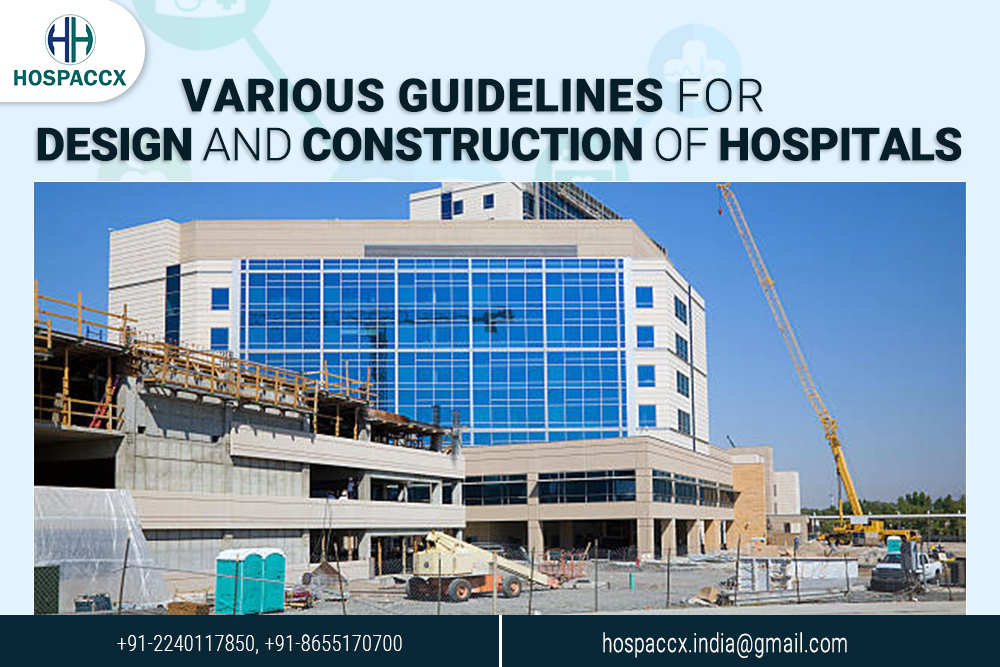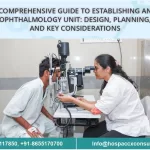Hospital is a very complicated structure. To design a hospital, it requires a professional and skilled designers and engineers. Hospaccx Business Healthcare Consultancy measures and maps all the required guidelines to construct a Hospital. In this article, Hospaccx has mentioned all the general requirements and guidelines required to build a hospital. If you need a refined market and financial feasibility or any other study related to healthcare, you can contact Hospaccx Healthcare Business Consulting Pvt. Ltd on hospaccx.india@gmail.com or you can visit our website on https://hospaccxconsulting.com
INTRODUCTION
A functional design can promote skill, economy, conveniences, and comforts; a non-functional design can impede activities of all kinds, detract from the quality of care, and lift costs to intolerable levels. Hospitals are the foremost complex of building types. Each hospital is comprised of a good range of services and functional units. These include diagnostic and treatment functions, like clinical laboratories, imaging, emergency rooms, and surgery; hospitality functions, like food, service and housekeeping; and therefore, the fundamental inpatient care or bed-related function. This diversity is reflected within the breadth and specificity of regulations, codes, and oversight that govern hospital construction and operations. Each of the wide-ranging and constantly evolving functions of a hospital, including highly complicated mechanical, electrical, and telecommunications systems, requires specialized knowledge and expertise. Nobody person can reasonably have complete knowledge, which is why specialized consultants play a crucial role in hospital planning and style. The functional units within the hospital can have competing needs and priorities. Idealized scenarios and strongly-held individual preferences must be balanced against mandatory requirements, actual functional needs (internal traffic and relationship to other departments), and therefore the financial status of the organization.
Hospitals are among the most regulated of all building types. Like other buildings, they must follow the local and/or state general building codes. However, federal facilities on federal property generally need not comply with state and local codes but follow federal regulations. To be licensed by the state, the design must comply with the individual state licensing regulations. There are different types of boards that provide different types of guidelines to construct the Healthcare facilities.
BOARDS THAT PROVIDE GUIDELINES FOR DESIGNING THE HOSPITALS & TEACHING HOSPITALS IN INDIA:
- NABH (National Accreditation Board for Hospitals & Healthcare Providers)
- MCI (Medical Council of India)
- NBC (National Building Code)
- NABL (National Accreditation Board for Testing and Calibration Laboratories)
- JCI (Joint Commission International)
To design or construct a hospital following general requirements can be taken into consideration:
- Environment: A hospital and other health facilities shall be located that it is readily accessible, free from undue noise, smoke, dust, foul odor, flood, and shall not be located adjacent to railroads, freight yards, children’s playgrounds, airports, industrial plants, disposable plants.
- Occupancy: A building designed for hospital/healthcare facilities shall be used only for this purpose.
- Safety: A hospital and other health facilities shall provide and maintain a safe environment for patients, personnel, and the public.
The building shall be of such construction so that no hazards to the life and safety of patients, personnel, and public exist. It shall be capable of withstanding weight and elements to which they may be subjected.
- Exits shall be restricted to the following types: door leading directly outside the building, interior stair, ramp, and exterior stair.
- A minimum of two exits, remote from each other, shall be provided for each floor of the building.
- Exits shall terminate directly at an open space to the outside of the building.
4. Security: A hospital and other health facilities shall ensure the security of persons and property within the facility.
5. Patient Movement: Spaces shall be wide enough for free movement of patients, whether they are on beds, stretchers, or wheelchairs. Circulation routes for transferring patients from one area to another shall be available and free at all times.
- Corridors for access by patient and equipment shall have a minimum width of 2.44 meters.
- Corridors in areas not commonly used for bed, stretcher, and equipment transport may be reduced in width to 1.83 meters.
- A ramp or elevator shall be provided for ancillary, clinical and nursing areas located on the upper floor.
- A ramp shall be provided as access to the entrance of the hospital, not on the same level of the site.
6. Lighting: All areas in a hospital and other health facilities shall be provided with sufficient illumination to promote comfort, healing, and recovery of patients and to enable personnel in the performance of work.
7. Ventilation: Adequate ventilation shall be provided to ensure the comfort of patients, personnel and the public.
8. Auditory and Visual Privacy: A hospital and other health facilities shall observe acceptable sound level and adequate visual seclusion to achieve the acoustical and privacy requirements in designated areas allowing the unhampered conduct of activities.
9. Water Supply: A hospital and other health facilities shall use an approved public water supply system whenever available. The water supply shall be potable, safe for drinking and adequate, and shall be brought into the building free of cross-connections.
10. Waste Disposal: Liquid waste shall be discharged into an approved public sewerage system whenever available, radioactive waste and other hazards liquid waste to be collected and treated following international rules and solid waste shall be collected, treated, and disposed of following applicable codes, laws or ordinances.
11. Sanitation: Utilities for the maintenance of the sanitary system, including approved water supply and sewerage system, shall be provided through the buildings and premises to ensure a clean and healthy environment
12. Housekeeping: A hospital and other health facilities shall provide and maintain a healthy and aesthetic environment for patients, personnel, and the public.
13. Maintenance: There shall be an effective building maintenance program in place. The buildings and equipment shall be kept in a state of good repair. Proper maintenance shall be provided to prevent the untimely breakdown of buildings and equipment.
14. Material Specification: Floors, walls, and ceilings shall be of sturdy materials that shall allow durability, ease of cleaning, and fire resistance.
15. Segregation: Wards shall observe the segregation of sexes. Separate toilets shall be maintained for patients and personnel, male and female.
16. Fire Protection: There shall be measures for detecting fire such as fire alarms in walls, Peepholes indoors, or smoke detectors in ceilings. There shall be devices for quenching fire such as fire extinguishers or fire hoses that are easily visible and accessible in strategic areas.
17. Signage: There shall be an effective graphic system composed of several individual visual aids and devices arranged to provide information, orientation, direction, identification, prohibition, warning, and official notice considered essential to the optimum operation of a hospital and other health facilities.
18. Parking: A hospital and other health facilities shall provide a parking space
19. Zoning: The different areas of a hospital shall be grouped according to zones as follows:
- Outer Zone – areas that are immediately accessible to the public: emergency service, outpatient service, and administrative service. They shall be located near the entrance of the hospital.
- Second Zone – areas that receive workload from the outer zone: laboratory, pharmacy, and radiology. They shall be located near the outer zone.
- Inner Zone – areas that provide nursing care and management of patients: nursing service. They shall be located in private areas but accessible to guests.
- Deep Zone – areas that require asepsis to perform the prescribed services: surgical service, delivery service, nursery, and intensive care. They shall be segregated from the public areas but accessible to the outer, second and inner zones
- Service Zone – areas that provide support to hospital activities: dietary service, housekeeping service, maintenance and motor pool service, and mortuary. They shall be located in areas away from normal traffic.
- Function: The different areas of a hospital shall be functionally related to each other;
- The emergency service shall be located on the ground floor to ensure immediate access. A separate entrance to the emergency room shall be provided.
- The administrative service, particularly admitting office and business office, shall be located near the main entrance of the hospital. Offices for hospital management can be located in private areas.
- The surgical service shall be located and arranged to prevent non-related traffic. The operating room shall be as remote as practicable from the entrance to provide asepsis. The dressing room shall be located to avoid exposure to dirty areas after changing to surgical garments.
- The delivery service shall be located and arranged to prevent non-related traffic. The delivery room shall be as remote as practicable from the entrance to provide asepsis. The dressing room shall be located to avoid exposure to dirty areas after changing to surgical garments. The nursery shall be separate but immediately accessible from the delivery room.
- The nursing service shall be segregated from public areas. The nurse station shall be located to permit visual observation of patients. Nurse stations shall be provided in all inpatient units of the hospital.
- Inwards the Rooms shall be of sufficient size to allow for workflow and patient movement.
- Inwards, the Toilets shall be immediately accessible from rooms.
- The dietary service shall be away from morgue.
CONCLUSION
This study concludes that the hospital is a very complicated structure, so to build up a hospital it requires general guidelines that are published by different boards to meet the needs. Skilled professionals and designers required to design and construct a hospital.
If you need any support in Planning and Designing a new Hospital you can contact us: Hospaccx healthcare business consulting Pvt. Ltd on: hospaccx.india@gmail.com. Or you can visit our website https://hospaccxconsulting.com/
Related Team Members




















